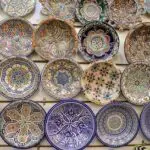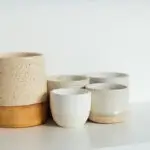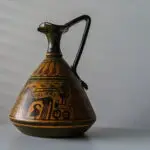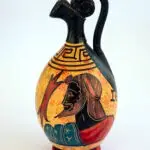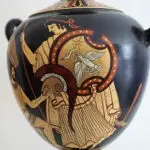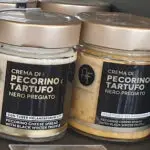Mediterranean pottery has been an essential part of the region’s culture and life for thousands of years. From kitchen pottery in the ancient Mediterranean to the red-figure pottery of ancient Athens, pottery has played a significant role in the Mediterranean world. Pottery is not only a functional object but also a symbol of cultural significance, artistic expression, and a way to connect with the past.
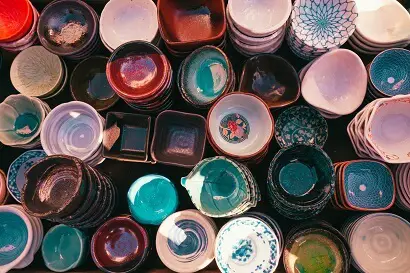
Pottery in the Mediterranean was not only used for daily life but also for rituals, ceremonies, and special occasions. The symbolism and meaning behind Mediterranean pottery were often reflected in the pottery’s design, motif, and decoration. The preservation and revival of Mediterranean pottery have become a significant area of study in archaeology and the science of kitchen pottery. The study of pottery contributes to our understanding of the ancient Mediterranean world and its culture.
Key Takeaways
- Pottery has played a significant role in the Mediterranean world for thousands of years.
- Mediterranean pottery is not only a functional object but also a symbol of cultural significance and artistic expression.
- The study of pottery contributes to our understanding of the ancient Mediterranean world and its culture.
Role of Pottery in Mediterranean Culture
History
Pottery has played a significant role in Mediterranean culture for thousands of years. The earliest known pottery in the Mediterranean dates back to the Neolithic period, around 4300 BC. Since then, pottery has been an essential part of daily life, rituals, and artistic expression throughout the region’s history. Pottery vessels were used for cooking, storage, and transportation. They were also used as grave goods, providing insight into ancient burial practices.
Daily Lives
Pottery was an essential part of daily life in the Mediterranean. From cooking pots to water jugs, pottery vessels were used for a variety of purposes. They were often decorated with intricate designs, making them both functional and aesthetically pleasing. In some areas, pottery was used to store and transport olive oil and wine, two of the region’s most important products.
Rituals and Ceremonies
Pottery played a crucial role in Mediterranean rituals and ceremonies. In ancient Greece, pottery was used in funeral rites to hold offerings to the gods. In Rome, pottery was used in religious ceremonies and was often inscribed with the name of the deity being honored. In some areas, pottery figurines were used in fertility rituals, representing the goddess of fertility.
Artistic Expression
Pottery has been a form of artistic expression in the Mediterranean for centuries. From the intricate designs of ancient Greek pottery to the colorful majolica of Renaissance Italy, pottery has been used to create beautiful and functional works of art. In some areas, pottery was used to create sculptures, such as the famous Tanagra figurines of ancient Greece.
Technology and Techniques
Pottery technology and techniques have evolved over time in the Mediterranean. From the earliest hand-built pots to the wheel-thrown vessels of ancient Greece and Rome, pottery has been shaped by advances in technology. Firing techniques have also evolved, from the open fires of ancient times to the kilns of the Middle Ages. Glazes and slips have been used to decorate pottery, adding color and texture to the finished product.
In conclusion, pottery has played a vital role in Mediterranean culture for thousands of years. From its use in daily life to its importance in rituals and artistic expression, pottery has been an essential part of the region’s history. The technology and techniques used to create pottery have evolved over time, but the cultural significance of this ancient craft remains unchanged.
Symbolism and Meaning in Mediterranean Pottery
Mediterranean pottery has been found to have significant cultural and symbolic value. The decorative techniques used on pottery, as well as the symbols and meanings associated with them, provide insight into the beliefs and practices of ancient Mediterranean cultures.
Faience
Faience, a type of glazed pottery, was widely used in ancient Egypt and the Near East. The blue-green color of faience was associated with fertility and rebirth and was often used in amulets and other religious objects. Faience was also used to create figurines of gods and goddesses, which were believed to hold magical powers.
Dictionary of Symbols
A dictionary of symbols was used by Mediterranean cultures to convey meaning through their pottery. For example, the spiral symbol represented the cycle of life, death, and rebirth in ancient Greece. The swastika symbol, which has been used in many cultures throughout history, represented good luck and prosperity in ancient Rome.
Ancient Greeks
Ancient Greek pottery was highly decorated with symbols and images that represented their culture and beliefs. The krater, a type of large vase used for mixing wine and water, was often decorated with scenes from Greek mythology. The owl symbol, which was associated with Athena, the goddess of wisdom, was a common motif in Greek pottery.
Egypt
Egyptian pottery was often decorated with hieroglyphics, which were used to convey meaning and tell stories. The lotus flower, which was associated with rebirth and the afterlife, was a common symbol on Egyptian pottery. The scarab beetle, which was believed to represent the sun god Ra, was also a popular motif on Egyptian pottery.
Rome
Roman pottery was often decorated with scenes from everyday life, such as hunting and fishing. The use of glazes and colors was also important in Roman pottery, with red and black being the most common colors used. The eagle symbol, which was associated with Jupiter, the king of the gods, was a popular motif in Roman pottery.
Overall, Mediterranean pottery provides valuable insight into the beliefs and practices of ancient cultures. The symbols and meanings associated with pottery provide a glimpse into the spiritual and cultural lives of these societies.
Mediterranean Pottery as an Artistic Expression
Mediterranean pottery is not only functional, but it is also a form of artistic expression that has cultural significance. The pottery created in the Mediterranean region has been used for centuries to create beautiful, intricate designs that reflect the region’s unique history and culture.
Bowls
Bowls are one of the most common forms of Mediterranean pottery and have been used for a variety of purposes throughout history. These bowls often feature intricate designs that are both beautiful and functional. The designs on these bowls often reflect the cultural and historical significance of the region. For example, some bowls feature designs that depict scenes from ancient Greek mythology, while others feature designs that reflect the region’s Islamic heritage.
Plates
Plates are another form of Mediterranean pottery that has been used for centuries. These plates often feature intricate designs that are both beautiful and functional. The designs on these plates often reflect the cultural and historical significance of the region. For example, some plates feature designs that depict scenes from ancient Rome, while others feature designs that reflect the region’s Byzantine heritage.
While Mediterranean pottery is unique in its own right, it has also influenced pottery in other parts of the world. For example, Japanese pottery has been heavily influenced by Mediterranean pottery, particularly in terms of the use of intricate designs and patterns.
Overall, Mediterranean pottery is an important form of artistic expression that has cultural significance. The intricate designs on bowls and plates reflect the region’s unique history and culture and have influenced pottery in other parts of the world.
The Use of Pottery in Rituals, Ceremonies, and Special Occasions in Mediterranean Cultures
Pottery has played an essential role in Mediterranean cultures for centuries, serving as a vital component of rituals, ceremonies, and special occasions. From cooking and serving to decorative and symbolic purposes, pottery has been an integral part of Mediterranean culture.
Cooking and Serving
Pottery ceramics have been used for cooking and serving food for thousands of years in the Mediterranean. The use of pottery ware, including amphorae, in cooking has been popular in Mediterranean cultures due to its ability to retain heat and cook food evenly. Ceramic pots, casseroles, and tagines are some of the most common types of pottery vessels used for cooking.
In Italy, pottery has been a staple in the kitchen for generations. The use of terracotta pots for cooking traditional Italian dishes, such as pasta sauces, has been a long-standing tradition. Terracotta pots are also used for baking bread, roasting meats, and cooking stews. The porous nature of terracotta allows for slow and even cooking, resulting in tender and flavorful dishes.
Italy
In Italy, pottery has played a significant role in the country’s culture and history since antiquity. Italian pottery is known for its intricate designs and vibrant colors, making it a popular choice for decorative purposes. Pottery has been used in Italy for centuries to create beautiful and functional pieces, such as vases, plates, and bowls.
In addition to decorative purposes, pottery has also played a role in Italian religious and cultural traditions. For example, in the southern region of Puglia, pottery is used to create traditional nativity scenes during the Christmas season. The nativity scenes feature handcrafted pottery figurines, including the Holy Family, the Three Wise Men, and farm animals.
Overall, pottery has been an essential part of Mediterranean culture, serving as a functional and decorative component of rituals, ceremonies, and special occasions. From cooking and serving to religious and cultural traditions, pottery has played a vital role in Mediterranean cultures for centuries.
Preservation and Revival of Mediterranean Pottery
Mediterranean pottery has been a significant part of the region’s cultural heritage for thousands of years. While many ancient pottery pieces have been lost to time, some have been preserved and continue to be studied today. The preservation of these pieces has been crucial in understanding the history of the Mediterranean region, including its trade routes, cultural interactions, and artistic traditions.
In recent years, there has been a revival of interest in Mediterranean pottery. This revival has been driven by a growing appreciation for the cultural significance of these artifacts and a desire to preserve this heritage for future generations. Many organizations and individuals have taken steps to preserve and promote Mediterranean pottery, including museums, archaeologists, and potters.
One way that Mediterranean pottery is being preserved is through the use of digital technologies. Advances in 3D scanning and printing have made it possible to create detailed digital models of ancient pottery pieces. These models can be used to study and analyze the pieces without risking damage to the originals. Additionally, digital technologies have made it possible to create replicas of ancient pottery pieces, allowing people to experience and appreciate these artifacts without risking damage to the originals.
Another way that Mediterranean pottery is being preserved is through the revival of traditional pottery-making techniques. Many potters in the region are working to keep these techniques alive by using traditional materials and methods to create new pottery pieces. This revival has not only helped to preserve the cultural heritage of the region but has also created new opportunities for artisans and small businesses.
Overall, the preservation and revival of Mediterranean pottery are essential for understanding the cultural significance of the region and preserving this heritage for future generations. Through the use of digital technologies and the revival of traditional techniques, it is possible to ensure that these artifacts continue to be studied, appreciated, and enjoyed for many years to come.
- The Top Restaurants Specializing in Truffle Dishes - August 10, 2023
- Truffle Panna Cotta: A Decadent Dessert Recipe for Truffle Lovers - August 7, 2023
- Truffle Scrambled Eggs: A Luxurious Breakfast Delight - August 7, 2023

